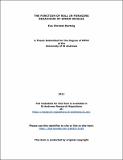The function of roll in foraging behaviour of sperm whales
Abstract
Though direct experiments to test echolocation in sperm whales (Physeter
macrocephalus) remain impossible, the indirect evidence is overwhelming that one
function of their clicks is echolocation used during foraging, as has been shown for other
toothed whales. In this thesis, the aim was to test: 1) the hypothesis by Fristrup and
Harbison (2002) that the sperm whale might be using downwelling light during the day to
spot prey or prey patches as silhouettes against the lighter sea surface. 2) A second
hypothesis by Fristrup and Harbison (2002) suggested that the sperm whales use vision to
look for bioluminescence in prey at depth, or during the night when no light is available.
3) Indications that the sperm whales changed their roll-behaviour, rolling more
extensively when they were producing regular clicks during the descent as well as for the
ascent. Data from 51 sperm whales tagged in the Gulf of Mexico, the Atlantic, the
Mediterranean and northern Norway, were tested to explore how large a proportion of the
bottom-interval the whales spent at angles where they were able to see towards the lighter
sea surface at three different pitch-modes while either searching or buzzing, for each
dive. The majority of whales were found to be swimming predominantly upside down or
on the side during both the day and night time. The whales were not found to change the
way they use roll at night compared to the day time, when looking at the bottom-interval
when the whales were both searching for prey and buzzing.
Looking at another function for roll and a possible association with the
echolocation of the sperm whales, it was found that during the descent, the whales had a
tendency to have a higher variance of roll when they were producing regular clicks. A
very similar trend showed for the ascent-phase as well, that they seemed to roll more
when clicking compared to when they were not, before they reached the sea surface.
These analyses of the roll-behaviour of sperm whales used to test the hypotheses put
forward by Fristrup and Harbison do not seem to support the use of vision to detect prey
during foraging at depth, but might indicate that the sperm whale was intentionally
changing its roll-behaviour, when they were producing regular clicks during the ascent
and descent-phase in the Gulf of Mexico, the Atlantic, the Mediterranean and Norway.
Type
Thesis, MPhil Master of Philosophy
Collections
Items in the St Andrews Research Repository are protected by copyright, with all rights reserved, unless otherwise indicated.

